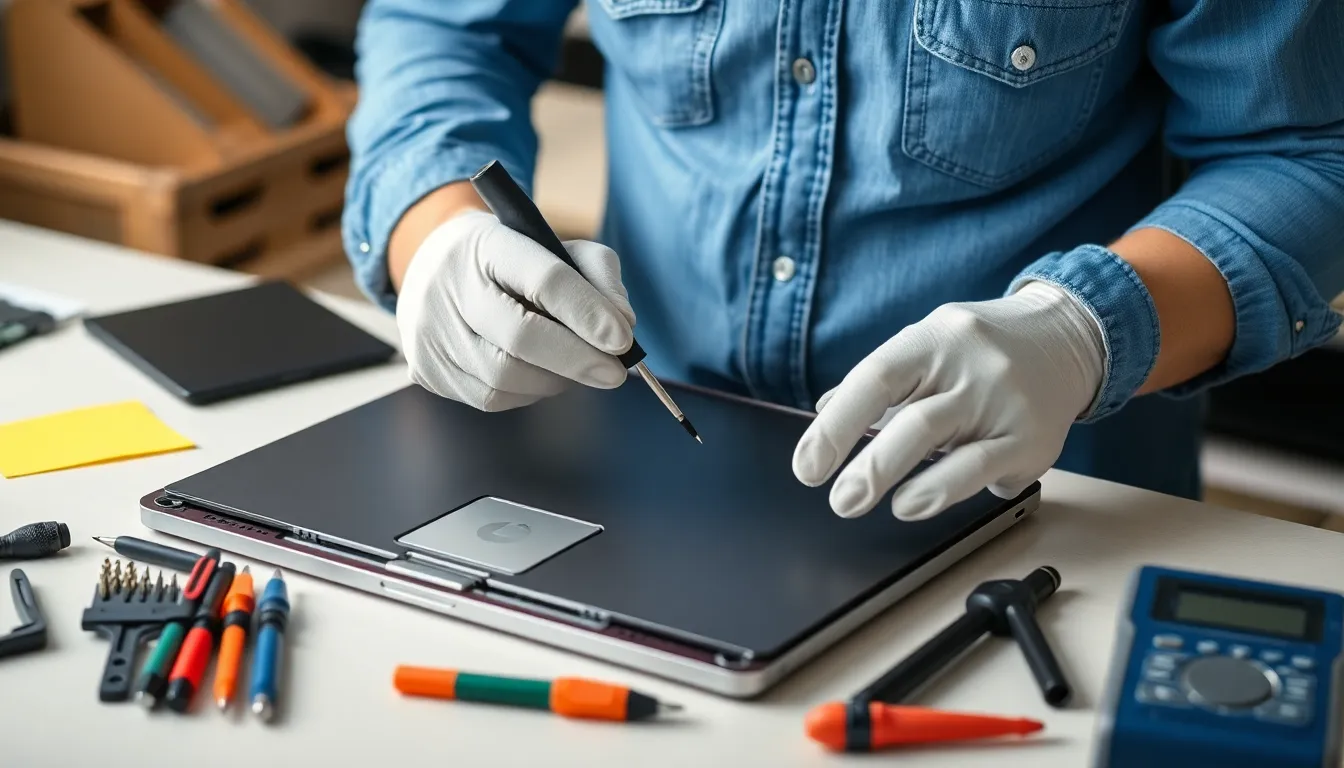Laptops are like loyal sidekicks—always ready to assist with work, play, and everything in between. But when they start acting up, it’s like they’ve decided to go on strike. A cracked screen or a stubborn battery can turn even the most patient user into a tech-wrangling cowboy. Luckily, laptop repairs don’t have to be a wild west showdown.
Common Laptop Issues
Laptops experience a variety of issues that can hinder performance. Identifying these problems early can simplify the repair process.
Hardware Problems
Cracked screens often top the list of hardware issues. Loose connections can cause keyboard or trackpad malfunctions. Overheating issues usually arise from clogged vents or failing fans, leading to unexpected shutdowns. Battery failures can limit portability and productivity, making it crucial to check battery health regularly. Broken hinges may prevent the safe opening or closing of a laptop. Proper diagnosis of these hardware concerns enables efficient repairs and minimizes downtime.
Software Problems
System crashes usually indicate underlying software issues. Frequent freezes can result from insufficient memory or outdated software. Viruses or malware often disrupt normal laptop operation. Incompatibility issues may arise during software updates, leading to functionality loss. Slow performance typically stems from excessive background applications consuming resources. Addressing these software dilemmas ensures optimal laptop functionality and enhances overall user experience.
DIY Laptop Repairs

Performing laptop repairs at home saves time and money. Simple tools and methods can resolve common issues like screen cracks and battery failures effectively.
Tools Needed
Essential tools include a screwdriver set, plastic spudger, and tweezers. A microfiber cloth aids in cleaning components. Additionally, using thermal paste is crucial for CPU cooling solutions. Various storage solutions like anti-static bags enhance safety during repairs. Consider purchasing a multimeter to check battery health.
Step-by-Step Guide
Start with power off and unplugged devices before opening any laptop. Remove the back panel carefully using a screwdriver. Check for any visible damage to components next. Replace faulty parts such as screens or batteries following the manufacturer’s guidelines. Secure everything back in place and conduct a test run to ensure operational efficiency.
Professional Laptop Repair Services
Professional laptop repair services offer reliable solutions for a range of issues, from hardware failures to software glitches.
When to Seek Help
Recognizing the signs of serious laptop problems is crucial. If the laptop regularly crashes, displays persistent error messages, or fails to boot, seeking help is essential. A cracked screen or an overheating laptop indicates hardware issues that often require professional intervention. Frequent system freezes can disrupt productivity, making it difficult to complete tasks. Once a battery fails to hold a charge, replacing it becomes necessary for continued use. Users should consult with a technician when troubleshooting does not resolve these persistent issues.
Choosing the Right Service
Selecting the right laptop repair service involves several considerations. Start by researching customer reviews to gauge the reputation of potential services. Verify the technician’s experience with specific laptop brands and models for effective repairs. Check if the service offers warranties on parts and labor, which indicates confidence in their work. Price comparisons among local service centers help identify reasonable rates for necessary repairs. Lastly, inquire about turnaround times to ensure that repair schedules meet individual needs.
Preventive Measures for Laptop Maintenance
Laptop maintenance is essential for prolonging lifespan and preventing common issues. Implementing preventive measures can help maintain performance and reduce repair needs.
Regular Cleaning
Regular cleaning protects laptops from dust buildup and overheating. Dust accumulates inside vents and fans, which can lead to overheating. It’s advisable to use compressed air to blow out dust from vents every few months. Additionally, wiping down surfaces with a microfiber cloth prevents fingerprints and grime on screens and keyboards. Cleaning keyboards and ports prevents debris from affecting functionality. By committing to a routine cleaning schedule, users ensure optimal laptop performance and longevity.
Software Updates
Software updates enhance security and improve performance. These updates often include patches that fix bugs and vulnerabilities, ensuring the laptop runs smoothly. Scheduling regular checks for updates can keep systems secure and up to date. Enabling automatic updates can simplify this process and prevent missing critical updates. Users should also back up data before performing significant updates. Prioritizing software updates fosters a stable and efficient operating environment.
Laptop repairs don’t have to be daunting. By understanding common issues and knowing when to seek professional help, users can maintain their devices effectively. Embracing DIY repairs can empower individuals to tackle minor problems with confidence while recognizing the value of expert services for more complex challenges.
Implementing regular maintenance practices not only enhances performance but also extends the lifespan of laptops. With the right tools and knowledge, users can navigate repairs and keep their trusty companions running smoothly for years to come. Prioritizing care and timely interventions ensures a seamless digital experience.
